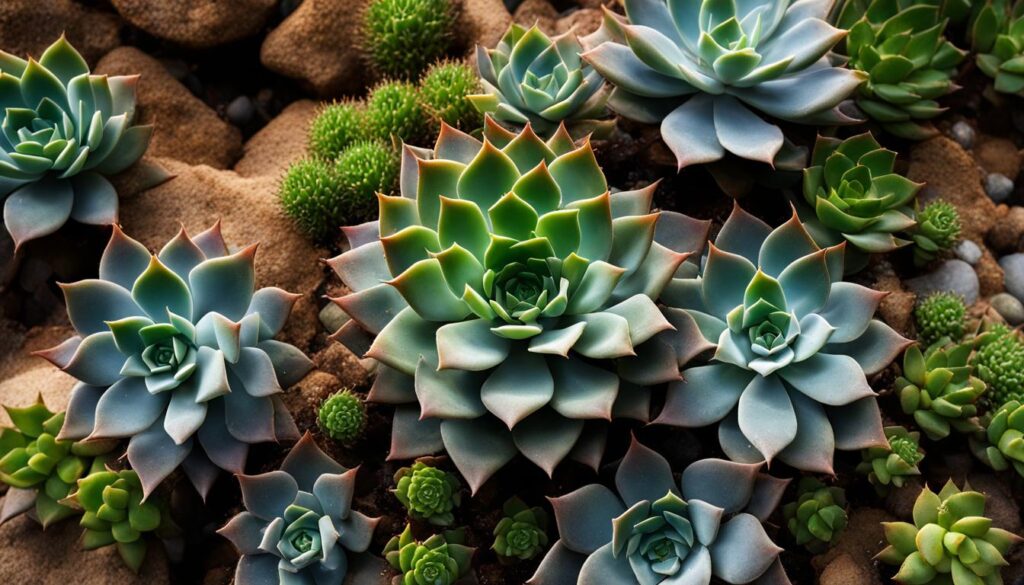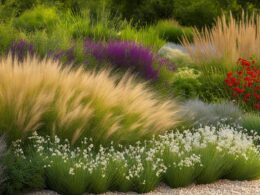Are you interested in creating an eco-friendly and water-efficient landscape? Look no further than organic xeriscape maintenance methods. By eliminating toxic synthetic pesticides and fertilizers and reducing water usage, you can transform your outdoor space into a lush and sustainable environment. Let’s explore the benefits and tips for organic xeriscape maintenance.
Key Takeaways:
- Organic xeriscape maintenance eliminates toxic synthetic pesticides and fertilizers.
- Reducing water usage through organic practices conserves water and protects groundwater.
- Mulch is an effective tool for weed control and water conservation in organic xeriscape maintenance.
- Organic waste can be reused as compost, reducing costs and promoting a sustainable landscape.
- Choosing drought-tolerant plants and reducing lawn areas are essential in xeriscape landscaping.
Benefits of Organic Xeriscape Maintenance
Organic maintenance methods for xeriscaping offer a multitude of benefits that make them an attractive option for environmentally-conscious homeowners. By utilizing these methods, you can reduce water usage, create a cost-effective landscape, and minimize the environmental impact of your outdoor space.
One of the major advantages of organic xeriscape maintenance is the reduction in water consumption. Through the use of mulch, which helps retain moisture in the soil, and strategic plant selection, you can significantly reduce your reliance on irrigation. This not only conserves water, but also lowers your water bill, making it a cost-effective solution in the long run.
Another benefit is the elimination of toxic pesticides and fertilizers. By opting for organic alternatives, you can create a safer environment for wildlife and reduce the risk of water contamination. Organic maintenance methods focus on natural solutions, such as composting and utilizing beneficial insects, to promote a healthy and balanced ecosystem in your landscape.
Promoting a Sustainable Future
Organic xeriscape maintenance methods not only benefit your immediate surroundings, but also contribute to a more sustainable future. By reducing the use of harmful chemicals and conserving water, you are actively playing a role in protecting the environment and preserving natural resources for future generations.
“Utilizing organic maintenance methods in xeriscaping not only creates a beautiful and sustainable landscape, but also supports a healthier ecosystem.”
Furthermore, organic maintenance practices can be aesthetically pleasing. Native plants that are adapted to the local climate not only require less water, but also add beauty and diversity to your landscape. Incorporating drought-tolerant flowers, shrubs, and grasses can create a visually appealing outdoor space while conserving water and reducing maintenance requirements.
In summary, the benefits of organic xeriscape maintenance include reduced water usage, cost-effective landscaping, and a positive impact on the environment. By embracing organic practices, you can create a lush and eco-friendly landscape that is both aesthetically pleasing and sustainable.
Organic Soils Management for Xeriscaping
Restoring and maintaining the natural nutrient cycling system is at the core of organic xeriscape maintenance. By adopting organic soil management practices, you can improve nutrient and moisture availability, suppress diseases, enhance aeration, and degrade pollutants in the soil without the use of synthetic or chemical methods.
One of the key benefits of organic soil management is its ability to retain valuable nutrients in the root zone. By incorporating organic matter into the soil, you create a nutrient-rich environment that supports healthy plant growth. Additionally, organic practices promote a symbiotic relationship between fungi and roots, enhancing nutrient availability. This mutually beneficial partnership aids in the uptake of essential nutrients, leading to improved plant health and vigor.
Moreover, organic soil management plays a vital role in disease suppression. Healthy soils with robust microbial activity and diverse populations of beneficial organisms can help protect plants from harmful pathogens. By fostering a balanced soil ecosystem, organic practices create an environment that naturally inhibits the growth and spread of diseases.
Another advantage of organic soil management is its ability to enhance moisture retention. Organic matter acts as a sponge, absorbing and holding water in the soil. This increased water-holding capacity reduces the need for frequent irrigation, helping to conserve water in xeriscape landscapes.
The benefits of organic soil management for xeriscaping include:
- Retaining valuable nutrients in the root zone
- Improving nutrient availability through symbiotic relationships
- Supressing diseases and promoting plant health
- Enhancing moisture retention and reducing water usage
- Creating a sustainable and eco-friendly landscape
Essential Tips for Xeriscape Landscaping
Creating a water-wise garden through xeriscape landscaping techniques not only helps conserve water but also promotes a sustainable and low-maintenance outdoor space. Here are some essential tips to consider:
1. Reduce or Eliminate Lawn Areas
Lawns require excessive water and maintenance, making them less suitable for water-wise gardening. Consider reducing or eliminating turf grass areas and replacing them with alternative ground cover options such as gravel, native plants, or ornamental grasses. This change not only reduces water usage but also adds visual interest and texture to your landscape.
2. Group Plants with Similar Water Requirements
One of the key principles of xeriscape landscaping is to group plants based on their water needs. This allows for efficient watering practices and prevents over or under watering. Create separate planting zones for plants with high, moderate, and low water requirements, ensuring that each zone receives the appropriate amount of water.
3. Use Drought-Tolerant Plants
Choose plants that are well adapted to arid and dry conditions, known as drought-tolerant plants. These plants have developed mechanisms to survive and thrive with minimal water. Consider incorporating native species, succulents, and Mediterranean plants into your landscape design. Not only will they require less water, but they will also add beauty and character to your garden.
4. Implement Drip Irrigation Systems
Efficient watering is crucial in water-wise gardening. Drip irrigation systems deliver water directly to the base of plants, minimizing water loss through evaporation and runoff. This method ensures that water reaches the roots where it is needed the most. Install a drip irrigation system that can be easily adjusted to accommodate the water requirements of different plant zones.
5. Apply Mulch for Soil Conservation
Mulching is an effective technique to conserve soil moisture and suppress weed growth. Apply a layer of organic mulch such as wood chips, straw, or bark around your plants to reduce evaporation and maintain soil temperature. Mulch also improves soil structure, promotes beneficial microbial activity, and prevents erosion.
By implementing these essential tips in your xeriscape landscaping project, you can create a beautiful, sustainable, and water-wise garden that thrives in arid conditions. Embrace water-wise gardening techniques and enjoy the benefits of reduced water usage, lower maintenance, and a visually appealing landscape.
Can Organic Methods Be Used for Xeriscape Maintenance, Especially for Beginners?
When it comes to xeriscape maintenance, especially for beginners, organic methods can definitely be utilized. From using natural mulch to planting drought-tolerant native plants, there are many xeriscape maintenance tips for beginners that can help create a low-maintenance and eco-friendly landscape.
Suitable Plants for Xeriscape Landscaping
When it comes to xeriscape landscaping, choosing the right plants is crucial. Opting for drought-tolerant and xeriscape-friendly options will ensure that your landscape thrives with minimal water usage. Native plants are an excellent choice as they are adapted to the local climate and require less water. Consider incorporating these beautiful and resilient plants into your xeriscape garden:
Drought-Tolerant Flowers:
- Coneflowers: These vibrant, daisy-like flowers come in a variety of colors and attract pollinators like bees and butterflies.
- Coreopsis: With their bright yellow or red blooms, coreopsis adds a pop of color to any xeriscape garden.
- Sedum: These low-maintenance succulents feature fleshy leaves and clusters of star-shaped flowers, perfect for rock gardens or containers.
Drought-Tolerant Shrubs:
- Blue Mist Shrub: This compact shrub produces clusters of small, fragrant flowers and adds a touch of blue to your landscape.
- Chokeberry: Known for its stunning fall foliage, chokeberry is a versatile shrub that can thrive in a variety of soil conditions.
- Butterfly Bush: As its name suggests, this shrub attracts butterflies with its vibrant blooms and sweet fragrance.
Xeriscape Grasses:
- Feather Reed Grass: This ornamental grass features tall, slender stalks and adds a graceful touch to any xeriscape garden.
- Fountain Grass: With its cascading foliage and striking plume-like flowers, fountain grass creates a dramatic focal point in the landscape.
- Switch Grass: This native grass offers a range of colors and forms, from blue-green blades to reddish-brown seed heads.
These plants not only conserve water but also enhance the beauty of your landscape. By incorporating them into your xeriscape garden, you can create a stunning outdoor space that thrives in even the most challenging conditions.
Conclusion
Organic xeriscape maintenance methods are an effective way to create a lush, water-efficient, and eco-friendly landscape. By eliminating toxic pesticides and fertilizers, reducing water usage, and using mulch and organic compost, homeowners can achieve a beautiful and sustainable outdoor space.
Xeriscape landscaping offers numerous benefits, including cost savings, reduced environmental impact, and a lower maintenance requirement. With proper planning and plant selection, xeriscape gardens can thrive in various regions and climates.
Embracing organic xeriscape maintenance methods empowers individuals to contribute to a more sustainable future while enjoying the beauty of their landscapes.













